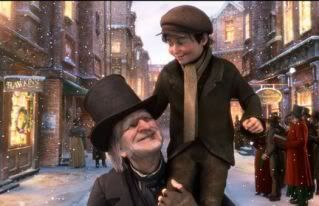 Well, this is disheartening: “Disney’s A Christmas Carol” decked the halls — and its competition — at the megaplex this weekend, earning $31 million in North America and guaranteeing that Robert Zemeckis gets to keep his mad dreams of motion-capture features alive for another few years.
Well, this is disheartening: “Disney’s A Christmas Carol” decked the halls — and its competition — at the megaplex this weekend, earning $31 million in North America and guaranteeing that Robert Zemeckis gets to keep his mad dreams of motion-capture features alive for another few years.
This makes me sad. Do you realize that Zemeckis hasn’t made a live-action feature since “Cast Away”, nine years ago? He’s spent most of this decade burrowing deeper and deeper into the digital realm, and what do we have to show for it? “The Polar Express”, “Beowulf” and the new thing.
Zemeckis hasn’t gone crazy or anything; he’s just followed his obsessions as far as he could, and ended up in the wrong place. His movies used to be light on their feet and filled with cinematic joy; around the time of “Forrest Gump”, they started to slip into self-importance and self-consciousness, with digital dazzle standing in for emotional beats, and now — with the exception of “Cast Away”, which strikes a balance between its elaborate construction and the rawness of Tom Hanks’ performance — they’ve been consumed entirely by technique. (There’s an interesting parallel here to Michael Mann, another director led astray by a different digital fetish.)
Dave Kehr, with whom I’ve had several entirely civil arguments about Zemeckis’ decline, interviewed the director for the New York Times’ holiday movie special last weekend; it’s a good piece, and you should read it. At no point does the director of “Used Cars”, “Back to the Future” and “Who Framed Roger Rabbit” acknowledge he now traffics exclusively in empty light shows, but I suppose that’s to be expected.
The real tragedy here? “Monster House” — which Zemeckis produced, but didn’t direct — is still the most entertaining example of motion-capture animation, precisely because it doesn’t attempt photo-realistic characters or settings. It embraces the unrealistic possibilities afforded by the process, and avoids most of the traps Zemeckis’ own films fall into. That has to sting.
Is Zemeckis just over-relying or misusing motion-capture technology in the same way that the latest wave of 3D movies frequently add nothing to the experience? There are exceptions, of course. “Up” used 3D to enhance the visual experience of the movie without, as I remember it, using it for simple audience jolts with something coming straight at the camera. The other 3D movies I’ve seen over the past few years have been all about the jolts. Motion-capture can be amazing – I would have been happy to see Andy Serkis get an Oscar nomination for his motion-capture portrayal of Gollum and the Lord of the Rings trilogy used the technology to integrate a character that moved and showed expression more realistically than any CGI than I’ve seen so far. It wasn’t at all about making something bigger, faster, etc. Nothing about Gollum struck me as gimicky. The animated movies I’ve seen over the past few years that have impressed me, have done so by moving me – “Up” being an excellent example, “Wall-E” another. Heck, even “Bolt” made me tear up at one point, but I’m a softee. At the end of all this, I guess I’m saying that even in a movie totally dependent on technology, it’s about story and character and emotion…not about the technology of the special effects. I may be in the minority – eg. “Transformers” gazillion dollars – but the technology should be a means to an end, not an apparent end in itself. There. Self-righteous audience rant over.